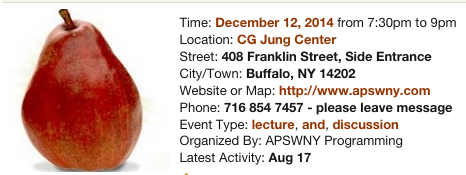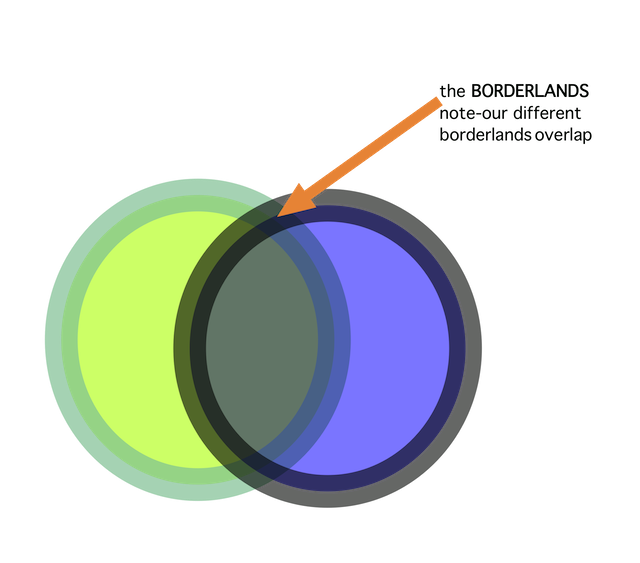Part One of Two
First you pour the water in the pool. Then you dive.
I’ve dived into the recent hours of intense creative dialog with Ken Warren. We’re preparing our presentation cum performance at The Society for Analytical Psychology of Western New York on December 12.

I’ll get to its description in a moment. First, let’s wander.
Systemics and cybernetics can be viewed as a metalanguage of concepts and models for transdisciplinarian use, still now evolving and far from being stabilized. This is the result of a slow process of accretion through inclusion and interconnection of many notions, which came and are still coming from very different disciplines. Systemics and Cybernetics in a Historical Perspective, Charles Francois, Systems Research Sciences and Behavioral Systems Research Sciences, #16
In short, directed at the above from 1999, Blow that shit up. Ken and I discuss our stuff, and we very seriously marry our paired, then dancing, intuitions. I could identify and then name and then post the essential contexts that inform our brotherly shamanism–and this would interest me more than him–yet most of those contexts are deliberately unstable.
Why? “inclusion and interconnection of many notions, which came and are still coming from very different disciplines,” souls.
We’ve been playing very hard in the overlap of our entangled sensibilities. We also play in the medial space described by the overlap, but, this medial space is outside our ‘pure’ overlap. Near where it’s bounded by the overlap we understand each other, but as our intuitions drift farther away from the overlap, or as our individual impulse reconnoiters closed to the unsharable territory in the other person’s homeland, he or I become tourists.

Yes, the medial aspects cross too. (Ken might attend to this using astropsychology, where I might propose a matrix of classification.) Still, the more one of us leaves behind both our home experience and the means that implicate our individual understanding of our, by definition, non-mutual experience, the more we traverse the medial boundary away from our core and toward the other person’s core.
Why do I mention this sort of map? For one thing, it’s a good example of third order social cybernetics, a framework I am in the process of hatching.
The two of us know something about what goes on betwixt us in our co-creative conversations. And we know that much just comes up from out of some nowhere, from the, as Ken would say, foamy depths.
What we know on our own obviously is a differential knowing, it regards my knowing being different than his knowing. That is not a trivial point. At the same time, we all the time drag one another into the medial territory for the purpose of revealing the so-called second-to-third orders ‘secreted’ there in the borderlands. The borderlands are where the action is!
Here’s the call for our program.
Repairing the Opposites, Doubling Stars, Turning Swine Into Pears
An experiential and imaginal exploration of relationship as individuation and daring-doWhat is any human system of relationship in relationship to, and contextualized by?
Is there deep value available in transforming important partnerships, friendships, and, pairings into sites for adventure?
How does activation of the Trickster archetype revitalize the approach of the single, yearning person?Using experiential learning, archetypal inquiry, and deep astrology, the principles of IN4tuity present an evening’s worth of games centered on the participatory psyche and sparking self-knowledge. Ken Warren and Stephen Calhoun use analytical psychology to bridge esoteric and cybernetic expertise. Their wild blend on this special evening aims to animate a circus of interactive exploration and discovery. Come prepared to play. Come ready to capture an epiphany or two about you and one other, even if the one other has not yet been met.
Pear. In Greek and Roman mythology, pears are sacred to three goddesses: Hera (Juno to the Romans), Aphrodite (Venus to the Romans), and Pomona, an Italian goddess of gardens and harvests.
The ancient Chinese believed that the pear was a symbol of immortality. (Pear trees live for a long time.) In Chinese the word li means both “pear” and “separation,” and for this reason, tradition says that to avoid a separation, friends and lovers should not divide pears between themselves.
In Christianity, the pear, rarely used except in paintings of the Renaissance and Baroque periods, symbolizes the fruit of Mary’s womb. St. Augustine remembered his first sin to be when he stole a pear. His original sin was mimetic with regard to the original sin in The Garden of Eden.
Stephen Calhoun is the principal of squareONE: experiential toolmakers. He recently became one of four worldwide learning partners of Experience-based Learning Systems, and, he is a founding member of the Experiential Learning Community of Practice.
Kenneth Warren is the founder and editor of House Organ, a letter of poetry and prose. BlazeVox recently published his selective history of American poetry: Captain Poetry’s Sucker Punch: A Guide to the Homeric Punkhole, 1980-2012.
I created the program in this way: 100% intuition, spontaneously, on a hunch. By 100% intuition I mean, following loosely from psychologist John Beebe: 50% extroverted intuition, and 50% introverted intuition; and by the latter I additionally mean, unconscious/occulted/demonic and of unknown origins.
Next step, to discuss with Ken what it is that is interesting to us both, and so find our hook in this 100% mutual intuitive build, a co-creation now consisting of half conscious and half unconscious interests brought together from our two different sides.
I am just about ready to adjust the program’s call to reflect what it is we will actually try to pull up, and pull off. Up to this point, Ken and I haven’t discussed my original program intuition at all.
What we have been discussing is the birth of romantic relationship, the initial soulful foray toward another soul, and, the paradoxical status of self-knowledge in both the light and dark zones of initial (and initiatory,) relating.
131. But if thou shut up thy Soul in the Body, and abuse it, and say, I understand nothing, I can do nothing, I am afraid of the Sea, I cannot climb up to Heaven, I know not who I am, I cannot tell what I shall be: What hast thou to do with god? for thou canst understand none of those Fair and Good things, and be a lover of the body and Evil.
132. For it is the greatest Evil, not to know God.
133. But to be able to know, and to will, and to hope, is the straight way, and Divine way, proper to the Good, and it will everywhere meet thee, and everywhere be seen of thee, plain and easy, when thou dost not expect or look for it; it will meet thee waking, sleeping, sailing, travelling, by night, by day, when thou speakest, and when thou keepest silence.
Part One of Two


Pingback: Liberating the Stars From Space & Time | squareONE explorations